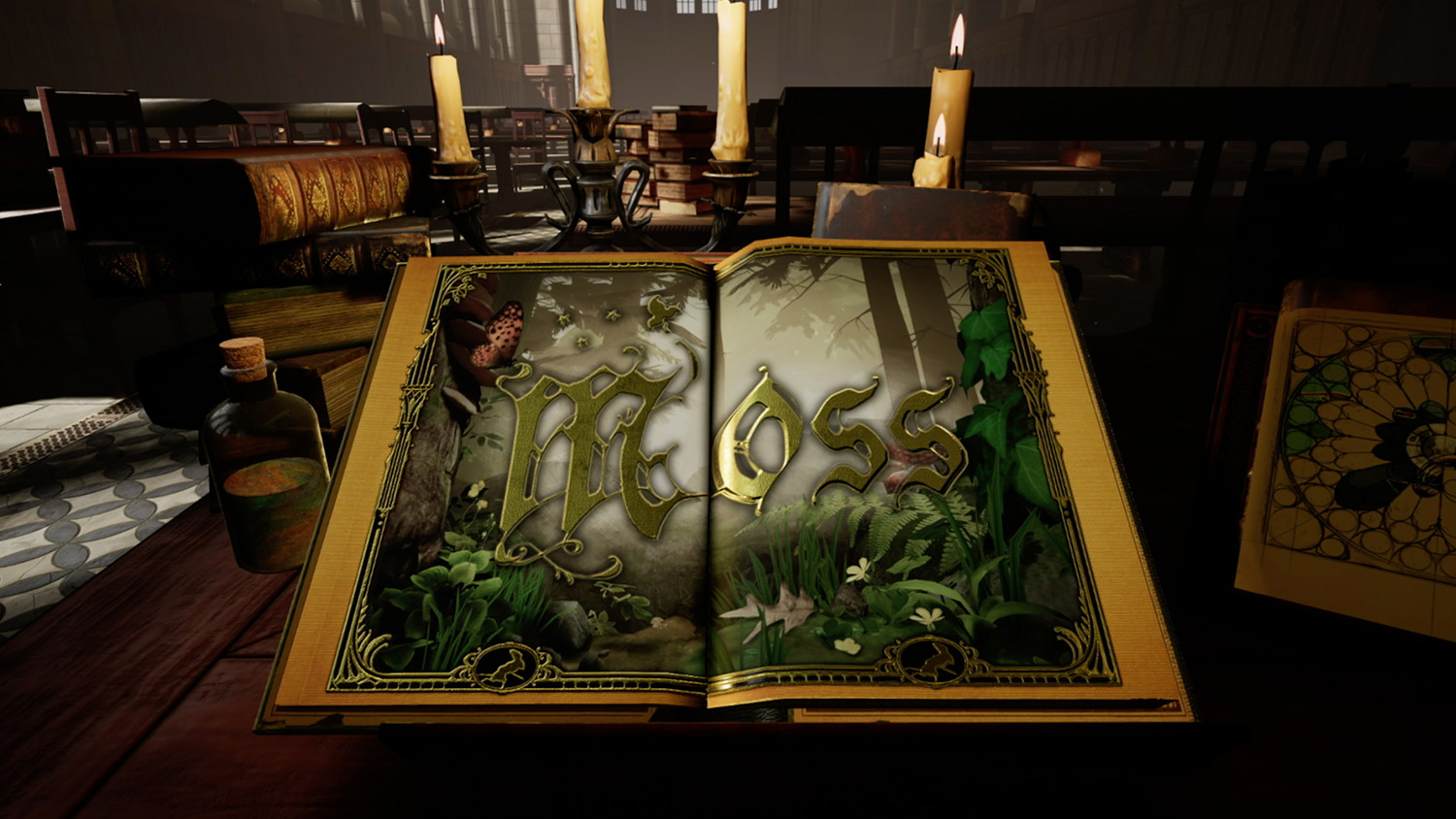The artists, developers, dreamers, and adventurers at Polyarc are multi-disciplined creators who love good storytelling. They draw their inspiration from many sources, including classic fantasy, games of all genres, and the natural world. Polyarc’s latest single-player release, Moss, follows the saga of our genuine and courageous heroine Quill. True VR gaming at its finest, Moss conveys an immersive, built-for-VR-from-the-ground-up, emotionally compelling story. Based in Seattle, Polyarc pushes the boundaries of the VR format by considering the player’s experience first and infusing human emotion in their characters and settings. We connected with Polyarc’s Co-Founder and Art Director Chris Alderson after the launch of the Moss Artist Shop to learn more about his team, their processes and work, and what drives them to create.

The founders of Polyarc originally worked at Bungie, home of Destiny, Halo, Myth, and Marathon to name just a few of their incredibly industry-leading games. How did their start with such an influential game maker inspire the work Polyarc does?
“Working at Bungie was an amazing experience and there is a lot of pride associated with working on those massive franchises and the influences they have on fans. It’s crazy to wear a shirt around town and for someone to say, “Oh yeah, ODST! I love that game!” That is a trip. The ways in which Bungie influenced Polyarc the most pertain to their philosophies around making truly triple-A, blockbuster experiences. Their high level of polish on shipping products is second to none, and Bungie’s focus on feel—which some would argue is the most important aspect of VR to get right—was a key learning to making sure Moss felt great when you play it.”
Any trade secrets from Bungie the founders learned and implemented when building Polyarc? How has Polyarc evolved beyond your founding?
“The way we formed Polyarc at the beginning was an amalgamation of learnings from every studio we’d ever worked at, combined with takeaways from building relationships and talking with multiple studios who made games we admired and asking them how they do it. We borrowed various business and cultural aspects that we liked, which helped us form a game studio where we’d want to spend our time. As we continue to grow, we like to hear from new team members what they like and dislike about their prior experiences to help shape Polyarc’s way of operating. We’re ever evolving in that way. When we started, it was just four of us in essentially a closet with a window, and now we’re close to 20 developers and about to move into our third office. I’m elated we’ve made it this far and can’t wait to see what’s next for us!”

When the team’s not working in digital mediums, what other forms does their art take? What’s the crossover from 2D to 4D look like?
“You can spot a good game developer when they also love creating at home. Some of us oil paint, sculpt, go to drawing jams, and work on personal video game projects. We also have DJs, band members, and script writers. It’s all so inspiring. The truth is, we spend so much of our time in VR trying to incorporate the feelings of classic paintings—we want you to feel like you’re in the painting when you play our games.”
Moss is a game rich in epic storytelling. What does the team’s process look like creating such an in-depth and imaginative story?
“Moss at its heart is an homage to all of the games and media we enjoyed playing and watching growing up, as well as stories read to us as children. We landed on the classic hero’s journey since it closely matched most of those stories that we loved. We knew we wanted our hero to go on an intimate adventure that you, the player, are also a part of. With those rough guidelines in place, we started focusing on world building. J.R.R. Tolkien created thousands of pages of lore with detailed facts (most of which were never mentioned in the Trilogy or the Hobbit) as a solid foundation for his storytelling. Learning about the approaches of greats like him helped inform our own approach, albeit on a smaller scale.”

How does where Polyarc is located in Seattle influence or inspire any of the environments that Quill explores?
“The Pacific Northwest greatly influenced the environments that you travel to in Moss. We tried to capture some of the feelings we’ve had while exploring right in our own backyard, like warm light hitting your face on a nice summer hike, or a cold breeze while exploring a cave. Most of the destinations resemble real-life settings and reference places we’ve been. For example, the beach scene was inspired by fond visits to the Oregon coast I had with my family as a child. The forest scenes, especially during Moss’s intro, were modeled after photos that our Animation Director Rick Lico took while simply walking around his home one day.”
Quill is a fearless but friendly protagonist. Who (imaginary or real) is she based on?
“Quill takes influences from a lot of places. One specific example that comes to mind is Nausicaä of the Valley of the Wind. She’s a strong, young warrior who can hold her own and protect her kingdom at any cost. A truly likeable character from all angles. For Quill, we wanted to remove any barriers that could get in the way from a true emotional connection. We took cues from the way our pets emote and made some subtle decisions like making sure her eyes felt lifelike and enlarging her ears so you could really see her emotions through the way they animate.”

How do the artists, engineers, animators, and other Polyarc team members work together to bring a complex game like Moss to life?
“Collaboration is a huge aspect of Polyarc. Cultivating an environment where it’s easy and encouraged to express ideas is essential. We make games with small teams of 15-20 developers, which makes communication as easy as turning your chair around. And, by necessity, small teams allow everyone to spread their wings. There is a lot of crossover between disciplines. Most of our artists code and our designers create artwork daily. We are creating a culture at Polyarc where everyone is a game developer and exploring outside of your comfort zone is encouraged. The idea is we want to make it so if you have a really cool idea, there’s nothing in the way of you sharing it.”
What games inspire the kind of work Polyarc does now? What games do you think are pushing gaming boundaries into the future?
“The introduction of VR was like pressing a reset button on what we thought about good game design. It’s an opportunity to start over and figure out what works in its most simple form. So naturally, we look to classic games for inspiration. The Legend of Zelda was a classic that helped inform the earliest incarnations of Moss. The games that will push the boundaries into the future for me are the ones that try to realize the right game design for the specific medium, not the ones that try to take an already existing game design and format it to fit VR. For example, I loved the way Astro Bot utilized VR because every mechanic had VR in mind, and they were doing a lot of things I’d never seen before in a video game.”

What games does the team like to play in their free time? Any game artists you draw inspiration from?
“At Polyarc we love all game genres. From Hearthstone to Mario Odyssey to Dead Cells, we play and draw inspiration from many different games. Coincidentally, we also love making all types of games. In the end, if Polyarc was known for a versatile catalogue of games, I’d be happy. One thing we all have in common is our attraction to character and story. I think that’s why I’m personally drawn to single player, story-driven games. Some inspirations are Kratos and the relationship he had with his son in God of War. And Playdead’s Inside had a feel and tone that blew my mind—that game greatly influenced Moss’s atmosphere and lighting.”
How do you determine the new environments that Quill will discover?
“Quill’s adventure and the places she goes mirror her emotions. We referenced destinations that made us feel how Quill is feeling on her adventure. The same goes for the way we lit each scene. When she’s happy, the light is warm and inviting and you’re surrounded by lush green forest, but when she’s at her lowest, we place you somewhere cold, damp, and dark.”

How has Quill’s story evolved or changed over time?
“We have a much larger story to tell and the first Moss game is just the beginning. Initially, the first game was going to have the full story we envisioned for Quill at that time. Due to time and budget, we ended up breaking up Quill’s and the player’s story arcs into smaller chunks, but that also meant we needed to make sure each contained adventure was satisfying on its own. We added in some new mini arcs and obstacles to overcome to ensure the game had enough story to satisfy a full release.”
How does the team balance what inspires your art form and what you feel drawn to create? What do you all do to refresh your artistic passions when you’re not feeling inspired?
“An important thing about project balance at Polyarc is making sure that what we’re making has enough variety to hold our attention throughout creating the entire project. The game must be challenging to make or else you’ll lose interest over time. Will you still be happy building this world after two or three years? Or longer? We may forgo going down a certain art direction solely because it’s not as fun to build. I have less interest in making ultra-realistic graphics as time goes by and one of the main reasons is because I’ve already done that. And when a project is finished, the best way to refresh artistic passion is to simply take a break. Try something brand new at the opposite end of the spectrum from what you’ve been doing this whole time. I’ve learned that only doing the thing you love will still eventually burn you out. You’ve got to be challenged and taken out of your comfort zone from time to time.”

What advice does Polyarc have for up-and-coming artists of all genres? What about just for game designers?
“My advice for up-and-coming artists and designers is to make the thing you’re passionate about. If you had a blast making something, it will shine through to the person at the other end who is experiencing it. If you aren’t passionate about the project for one reason or another, your next goal is to learn. If you aren’t learning, then it’s time to move on to the next thing.”
Any hints for where Quill’s story will lead next? What does the future hold in store for Moss?
“Without giving too much away… Quill and your relationship will be further tested. And not only will Quill’s story evolve, but so will your role as the reader of her story.”




